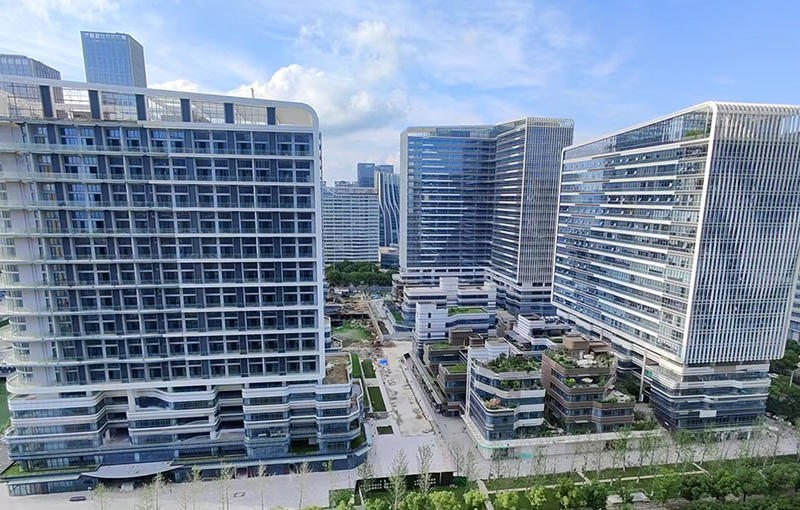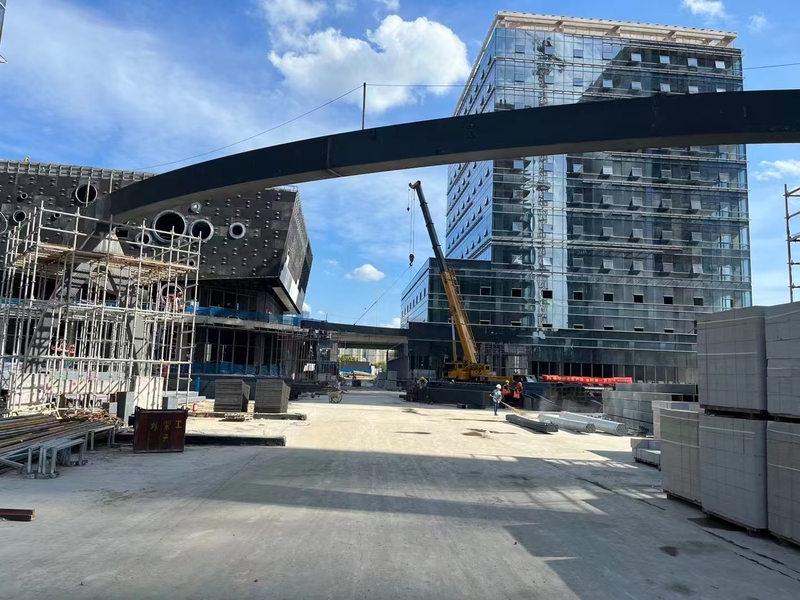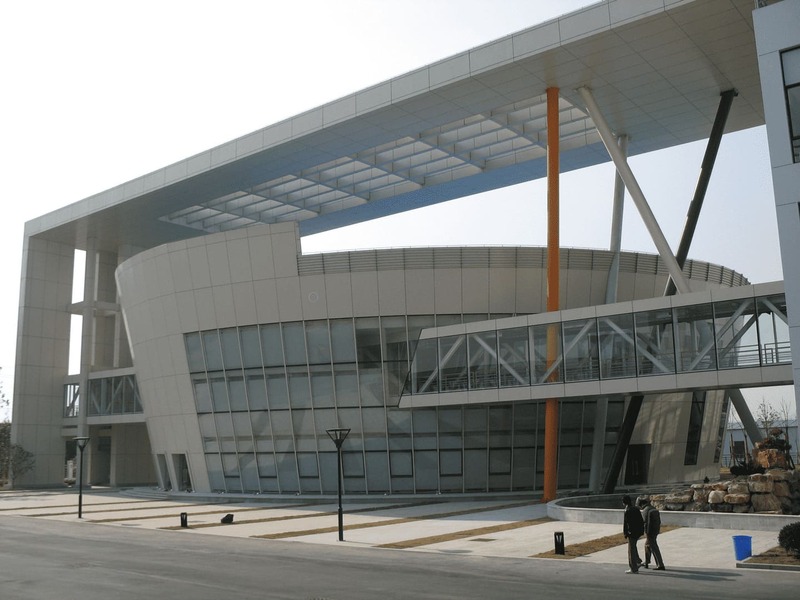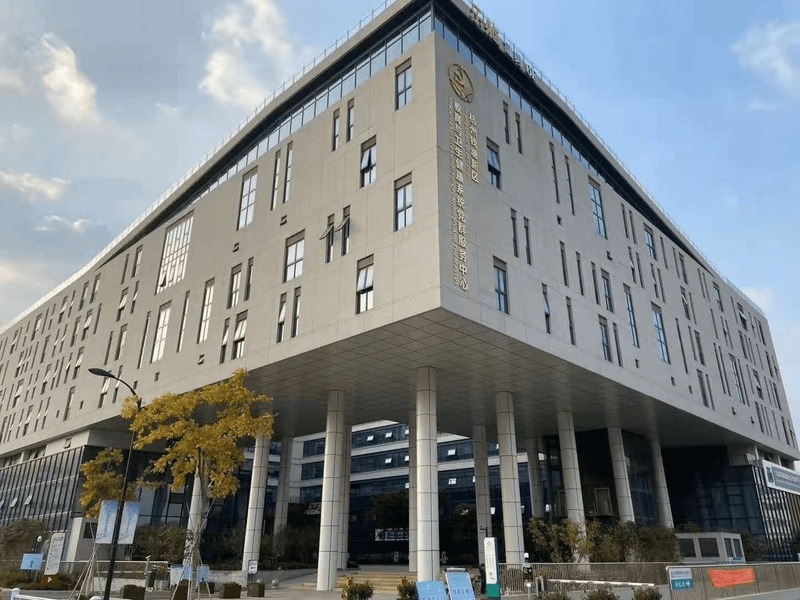1. Steel structure types suitable for office buildings
1. Steel-concrete composite frame structure (main solution)
Steel frames with concrete cores allow fast, clean construction—like building blocks. A 20-story office can be finished in 12 months, six months faster than concrete, with prefabricated parts bolted on-site for precision and fewer issues like leaks or cracks. Costs run $800–1000/m², saving 20% steel and 15% overall versus pure steel, balancing performance and cost.
(II) Large-span steel truss structure (flexible office scene)
Large-span steel trusses span up to 60m, ideal for open offices, atriums, and conference rooms. They boost space use by 30% over concrete beams and allow flexible layouts. With intelligent ceilings for acoustics and lighting, they enhance comfort. Environmentally, steel is over 90% recyclable, cuts waste by 85%, and reduces carbon emissions by 48%, aligning with green building trends.
2. Core advantages of steel structure office buildings
| Core Advantages | Technical Implementation | Owner benefits |
| Super load capacity | The steel-concrete composite structure has a bearing capacity of 8kN/m², meeting the heavy-load requirements of dense servers and archives in the financial industry. | No need for frequent reinforcement, reducing the risk of later transformation |
| Fast delivery | Factory prefabricated steel components (prefabrication rate ≥ 90%) + on-site modular assembly, the main body of the 30-story office building was capped in just 18 months | Early start-up and early returns, shortening the rental return cycle by more than one year |
| Spatial flexibility | Column-free and large-span design (standard column spacing 8-12 meters), the interior can be freely divided into open office, private negotiation area, etc. | Adapt to the adjustment of corporate organizational structure and reduce the cost of renovation and demolition |
| Intelligent safety system | Integrated facial recognition access control, intelligent smoke sensor linkage system, and seismic damper (earthquake displacement reduced by 50%) | Meet the security standards of Class A office buildings and enhance corporate image |
| Green and sustainable | Photovoltaic integrated roof (annual power generation meets 20% of office electricity) + exterior wall insulation rock wool board (energy saving rate reaches 65%) | Obtained LEED certification, enjoy green building subsidies, and reduce operating electricity costs by 30% |
3. Application scenarios and technical solutions
| Office Building Type | Typical scenarios | Technology Adaptation Solution | Performance Data | Cost reference |
| Grade A office building (city landmark) | Financial center, multinational corporate headquarters | 200-meter steel-concrete super high-rise + glass curtain wall system | Equipped with 50+ high-speed elevators, standard floor area of 2000㎡, wind load tolerance of 2.5kN/㎡ | $1200-1500 USD /㎡ |
| Corporate headquarters office building | R&D center, administrative office | Steel frame + concrete core + sky garden structure | The greening rate reaches 25%, and the acoustic noise reduction of the conference room is below 40dB | $900-1100 USD /㎡ |
| Creative Office Park | Technology business incubator, co-working space | Large span steel truss + removable partition system | Complete space redivision within 10 days to support “renovation while operating.” | $750-900 USD /㎡ |
4. Comparison with traditional concrete office buildings — Data shows why steel structures are the better choice
| Core Performance | Steel Structure – Concrete Solution | Traditional concrete solution |
| Basic bearing | The deadweight is reduced by 30%, the foundation treatment cost is reduced by 40%, and it is suitable for soft soil foundations | Deep pile foundation is required, and the cost increases by 20%-30% under complex geological conditions |
| Construction period (20 floors) | 12 months to complete the main construction | Main construction completed in 24 months, with a 100% extension of the construction period. |
| Retrofit flexibility | Modular components support 80% reuse and reduce transformation costs by 60% | The structure is difficult to dismantle, and the cost of functional change is high |
| Life cycle cost | The overall cost is 15%-20% lower than that of concrete (including the recovery value of steel) | The post-maintenance costs account for more than 35%, and the long-term costs are high |
| Shock resistance | Earthquake resistance of 8 degrees, the structure can be quickly repaired after an earthquake | Earthquake resistance level ≤ 7 degrees, high-intensity areas require additional reinforcement |
5. Key components and material standards – the quality details you care about
(I) Load-bearing system that makes the foundation of the house more stable
The “skeleton” of our office building is made of high-strength steel, just like putting on “reinforced armor” for the building:
Steel columns: Made of Q355B/C steel that is stronger than ordinary steel, they can withstand a pressure of 345- 420MPa, which is equivalent to more than 3 tons per square centimeter. “Shock-absorbing bearings” are also installed under the columns, just like the shock absorbers of cars, which can absorb 30% of the earthquake energy.
Even if an 8-degree earthquake occurs, it can remain stable and reduce the safety hazards caused by shaking.
Concrete core tube: The “concrete heart” in the middle is made of C50 high-performance concrete, which also contains steel plate shear walls. It has super wind resistance and can withstand a 12-level gale in coastal areas (wind load 3.0kN/m²). It is not afraid of typhoons and provides stable support for the building.
(II) A Floor system that makes the office more comfortable
Modern building floor and ceiling systems integrate a number of advanced technologies, significantly improving the comfort and functionality of the office environment. The floor adopts a composite structure of steel frame and concrete, with a thickness of 150 mm. Its excellent sound insulation performance (sound insulation ≥ 55 decibels) can effectively block noise interference such as meetings, walking, and moving objects in the upper space, ensuring the quietness of the office environment.
The intelligent ceiling system uses environmental adaptive technology to achieve intelligent linkage adjustment of the lighting system and natural light while maintaining indoor air comfort, saving 40% energy compared to traditional lighting, combining visual comfort and energy efficiency optimization, thus building a more efficient and healthy office space.
(III) High-performance thermal insulation and noise reduction enclosure system
The building enclosure structure adopts advanced thermal insulation and sound insulation design. The exterior wall system is composed of 250 mm-thick rock wool sandwich panels, filled with high-efficiency thermal insulation rock wool inside, and decorated with stone curtain walls on the outside.
The system has excellent thermal insulation performance (heat transfer coefficient K≤0.3W/(㎡·K)), which can effectively reduce heat loss in winter and cold dissipation in summer, significantly reduce building energy consumption, and save about 30% energy throughout the year. At the same time, the rock wool material meets the A1 fire protection standard and has excellent flame retardant properties, which can effectively inhibit the spread of fire and ensure building safety.
6. Frequently Asked Questions
Q1. Is the cost of a steel structure office building higher than that of a traditional reinforced concrete building? What is the cost-effectiveness?
The initial construction cost of a steel structure office building may be similar to that of a traditional building, but the overall cost-effectiveness is more advantageous. Steel can be prefabricated in factories, which reduces on-site construction losses, shortens the construction period by 30%-50%, and reduces labor and management costs; the steel structure is lightweight (about 1/3 of the concrete structure), which can save 20%-30% of the foundation engineering costs.
In the long run, steel structure buildings can be disassembled and recycled, and the material reuse rate exceeds 90%, which is in line with the concept of green buildings and is especially suitable for enterprises that need flexible transformation or may relocate in the future. In addition, the steel structure has a wide internal space, which can reduce wall partitions, increase the room rate by 5%-8%, and further improve the use efficiency.
| Comparison Dimensions | Steel structure office building | Traditional Architecture |
| Initial construction cost | It may be similar to traditional buildings, but the overall cost performance is more advantageous | / |
| Construction method and cost | Steel can be prefabricated in factories, reducing on-site construction losses, shortening the construction period by 30%-50%, and reducing labor and management costs | Mainly on-site construction, with relatively large losses, a long construction period, and high labor and management costs |
| Basic engineering costs | Light weight (about 1/3 of concrete structure), saving 20%-30% on foundation engineering costs | Large deadweight, high foundation engineering cost |
| Material Sustainability | Disassembled and recyclable, the material reuse rate exceeds 90%, in line with the concept of green building | Low material recycling rate |
| Space Utilization | The interior space is open, which can reduce wall partitions and increase the room rate by 5%-8%. | There are many walls, and the room rate is relatively low. |
Q2. What is the earthquake resistance of steel structure office buildings? Is their safety guaranteed?
Steel structures have excellent seismic resistance, and their toughness and ductility can effectively absorb seismic energy. The elastic modulus of steel is stable, the structure is light, and the inertial force generated under earthquake action is small. With reasonable node design (such as flexible connection and energy-absorbing support), the risk of structural damage can be significantly reduced.
For example, the seismic fortification intensity of steel structures using a frame-support system can reach more than 8 degrees, far exceeding the seismic requirements of most regions. At the same time, steel structures can meet the fire resistance limit required by the code (usually 1.5-3 hours) through anti-corrosion and fire-retardant coating treatment (such as ultra-thin fire-retardant coating). Combined with a complete fire protection system, the overall safety is fully controllable.
Q3. Is the interior space design of a steel structure office building flexible? Can it meet individual needs?
The “modular” characteristics of steel structures make their space design extremely flexible. The steel structure frame is supported by a column grid, and the walls do not need to bear structural loads. They can be freely dismantled or moved, making it easy to achieve a large, column-free, transparent space (such as an open office area, a high-ceiling exhibition hall), or quickly divide it into small compartments according to needs. In addition, steel structures allow pipelines to be pre-buried in floor trusses or run along the web of beams, avoiding the limitations of wall grooving in traditional buildings, and facilitating later equipment upgrades and line modifications.
For enterprises with special functional requirements (such as laboratories and data centers), customized design can also be used to achieve precise matching of floor height, load, and seismic resistance.
Q4. How long does it usually take to build a steel structure office building? Can the construction time be shortened?
Steel office buildings cut construction time by 40%–60% compared to concrete. Factory-prefabricated components allow simultaneous foundation work and on-site assembly. A 5-story steel office takes 6–8 months versus 12–15 for concrete, while modular systems can cap the main structure in as little as 4 months—saving time and costs for businesses needing quick use.
| Building Types | Construction period (taking a 5-story office building as an example) | Advantages |
| Steel structure office building | 6-8 months | Standardized steel components are prefabricated in the factory and assembled on-site. Foundation construction and component processing can be carried out simultaneously. |
| Steel structure office building (assembled) | Some projects will be capped within 4 months | Modular integrated construction is used to further shorten the construction period |
| Concrete Building | 12-15 months | Traditional construction methods have relatively complex procedures and long construction periods. |
Q5. What is the daily maintenance cost of a steel structure office building? How often does the anti-corrosion and fire-proofing need to be updated?
Steel structures have low maintenance costs, mainly for anti-corrosion and fireproof coatings. Hot-dip galvanizing (≥85μm) protects for 15–20 years, with rust spots repainted at $5–10/m² annually. Fireproof coatings last 10+ years for thick types, or 5–8 years for ultra-thin, costing 2–5 yuan/m² per year. Compared to frequent repairs in traditional buildings, steel structure maintenance is simpler and about 30% cheaper overall.
| Maintenance Project | Processing methods and standards | Protection/maintenance cycle | Average annual cost per square meter |
| Anticorrosion treatment | High-quality hot-dip galvanized coating (thickness ≥ 85μm) | 15-20 years (partial repainting) | $0.72-1.45 USD/year |
| Thick fire retardant coating | Cement-based thick fire retardant coating | 10+ years | $0.29-0.72 USD/year |
| Ultra-thin fire-retardant coating | Ultra-thin fire-retardant coating | 5-8 years re-inspection and re-coating | $0.29-0.72 USD/year |
| Traditional Architecture | High-frequency maintenance such as wall leakage repair and roof waterproofing renovation | – | (Comprehensive cost is 30% higher) |
XTD Steel Structure has extensive engineering experience, having successfully completed over 30 high-rise office building projects across multiple sectors such as finance, technology, and manufacturing. For example, the 25-story steel-concrete structure project for a certain internet company’s headquarters was delivered four months ahead of schedule, demonstrating our efficient construction capabilities. In terms of technological innovation, the company employs BIM technology for load simulation and pipeline integration, reducing on-site changes by 90%. Additionally, an intelligent monitoring system is used to track the structural health status in real-time, ensuring safety throughout the building’s lifecycle and providing clients with comprehensive quality assurance and peace of mind.





